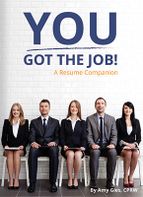
Tulips are blooming, the sun is shining, and the birds are chirping! That can only mean one thing – spring is here!
With spring often comes cleaning – a lot of cleaning. While you may dread spring cleaning each year, it really is the perfect time to take a hard look at things you never bother with the rest of the year. It’s a time for cleaning out closets, finally clearing out that junk drawer, or maybe even organizing the garage. But, it’s also the perfect time to clean up your resume!
When was the last time you looked at your resume? Let alone edited it? If you don’t know the answer to this question, it’s definitely time to do some resume spring cleaning.
Very similar to your closet, your resume changes as you change personally and professionally. When it comes to cleaning out your closet, you must go through all of your clothes and shoes and assess what still fits and what no longer does. What have you outgrown? What can you throw away? It’s the same with your resume.
As you progress in your career, you change and grow. Your skillset expands, you face and overcome new challenges, and your overall career story changes. Is that new promotion on your resume? What about that huge project you led for the entire team? If your resume doesn’t reflect where you currently are in your career and current position, it’s time for an update.
Now, you may be thinking to yourself: “but I’m not planning to apply for a new position anytime soon.” That’s okay! Whether you’re actively searching for a new job or are happy at your current company, you should regularly update your resume. That way, if the unexpected happens or if you happen to be invited to a networking event, you can be prepared for it.
So, now you know you should update your resume, but have no idea where to start. That’s where we come in! Check out our tips below for what to look for when embarking on your resume revamp.
Resume Spring Cleaning Checklist:
⃞ Carefully read it over. Read over your resume several times. Take the time to look it over with a fine-tooth comb to catch any errors, typos, or missing information. Go ahead and even read it out loud. This will help ensure you really read it and will make it easier to catch little mistakes you may have missed the first time.
Is your resume attention-grabbing and does it scan and flow easily? Recruiters usually take a few seconds to scan your resume for relevancy before moving on, so ensure you include the right “hook” in your summary statement as well as relevant wording (keywords) that you adopt from the job descriptions that fit your career trajectory. Once you’ve identified what’s missing, and what’s no longer relevant, you have a starting point for editing your resume and making it stand out.
⃞ Check for typos. Typos are a resume killer. Oftentimes, if a hiring manager sees a typo on your resume, they’ll immediately toss it aside and move on to the next candidate. But why? Because a typo on your resume shows that you didn’t take the time to carefully read it over. It shows a lack of attention to detail and reflects how you would perform at your new job. If you can’t show you’re serious about your resume, why should a hiring manager take you seriously?
⃞ Remove outdated information. Sure, it’s great that you graduated high school with a 4.0 GPA. It’s even more impressive that you graduated college with one as well. But does your high school and college information need to be on your resume? No. Keep the name of the college you attended as well as your degree, but any other information, such as college awards, internships, and accolades should be removed.
You should also check all licenses and certifications you have listed. Are any expired? If so, get rid of them. A good rule to follow is the 10-year rule. If you still have jobs listed from 10-15 years ago, delete them or minimize their importance (or real estate) on your resume! Anything older than 15 years weighs very little in importance unless it is highly relevant to the work you are doing now.
⃞ Remove the clutter. A cluttered resume won’t hold the attention of recruiters. So, how do you remove the clutter? It’s simple – don’t state the obvious. Eliminate overusing phrases or superfluous words, such as: including, resulted in, team player, multi-tasker, etc. Be concise and to the point and most importantly, show the recruiter your value with facts and numbers.
An overcrowded layout can also overwhelm recruiters and can be hard to scan and understand. And when you confuse, you lose. Make your resume easy to read by keeping it tightly organized using headings, bolding, and spacing to your advantage. Don’t shy away from adding color and stylizing your resume with your unique personality, but don’t make these additions overwhelming so that they detract from your messaging.
⃞ Identify the holes. What’s missing from your resume? Are there gaps in your work history you can fill in? Are there relevant experiences you’ve had that aren’t listed? What about that promotion? You didn’t include it!? Well, now is the time! Write out a list of everything you’ve accomplished since the last time you looked at your resume. Even if you volunteered or learned something new that is relevant to your career trajectory, don’t forget to mention it. Then, be sure your resume is as up-to-date as possible by adding anything important to that list.
⃞ Include new important information. Do you have new skills? Did you recently undergo training? Were you certified in something? Be sure to include any important additions to your skill set and career experience on your resume. Remember, many recruiters use applicant tracking systems (software that screens out resumes for relevancy) to screen out applicants, so adding a certain skill or tech competency can help your resume pass the screening and be read by recruiters personally!
⃞ Target your resume. Identify the type of position you’re applying for (or will be applying for in the future) and make sure your resume is tailored to it. Tailor your resume to the job description and be sure all of your experience and skills are centered around that specific position. A targeted resume is much more effective than a broad one that doesn’t zero in on job specifics.
Most employers want to minimize their risk when they hire a new employee, and the way they ensure that is by seeing that candidates have performed similar work beforehand or can use relevant skills to successfully perform required tasks.
The more you present yourself in a way that lowers resistance to hiring you by targeting your resume to the specific role and highlighting your impact in similar positions, you will stand out from the crowd and have a better chance to land your dream job. Therefore, take the time to customize your resume for every role. This extra time will make all the difference and can completely change your job search trajectory.
⃞ Check for keywords. Does your resume have keywords? If not, put them in! Keywords are very important in today’s job search, as they enable your resume to be found by applicant tracking systems. Not sure how to find the right keywords for your industry or position? Check out how to make a tag cloud by looking through the descriptions of the jobs you’re interested in and identify prevalent keywords that most of them use. What are the most mentioned skills desired? What technical expertise is most cited? Which words stand out the most? Then, be sure to sprinkle these keywords throughout your resume in a natural way that flows and doesn’t look forced.
⃞ Be sure to use industry terminology and phrases. Take the time to research your profession’s jargon and be sure to include it where possible. Also, look for any outdated jargon and remove it. For example, phrases that were used 10 years ago might not be used today, or may be referred to as something different. Using them could be a red flag to recruiters that you aren’t up-to-date on industry trends.
Additional Tips to Revamp Your Resume

Add LinkedIn and your portfolio
Most employers like to look through candidates’ LinkedIn profiles to get a sense of their professional activities, interests, and recommendations. If you don’t have a LinkedIn profile, we encourage you to set one up so that your professional presence is active and public.
In addition to a LinkedIn profile that you should hyperlink in your resume (if not possible, simply write out the link URL), having a visual representation of your work can help you showcase your talents in a way that is tangible and impressive. Depending on your industry, your portfolio can be housed on several websites for free, and should be also linked to your resume. Given the competition in the online world, especially for remote jobs, taking time to create an impressive portfolio will help you come out on top and align with the best opportunity for you.
Modernize your resume layout
Having a text resume without any visual design is something of the past. Today, job seekers have access to multiple design platforms that enable them to uniquely format their resumes with color, visual borders, and icon features. Canva and other design platforms offer resume templates where you can personalize your resume to show off your creativity and make it more visually appealing to recruiters.
One note to keep in mind is not to go overboard with the colors and graphics, which could distract the reader from the important information you provide. Likewise, we suggest that you don’t include graphs, tables, and visual blocks with important text. This is because these features may throw off the applicant screening software from reading the text effectively and may inadvertently screen out your resume for irrelevance.
Need Help Updating Your Resume?
Now that you know what to look for, it’s time to get to work cleaning up your resume! We hope these resume-cleaning tips were helpful. If you think your resume is too outdated to salvage, we can help!
Capstone Resume Services is a full-service resume-writing company. Our certified professional resume writers offer a variety of resume writing services – from executive resumes, federal resumes, and technology resumes, to cover letters, resume websites, and LinkedIn profiles.
We start the resume writing process with a personal resume consultation where we take the time to learn who you are and what you’ve experienced and achieved to ensure you stand out among the competition.
Get in touch with us today and take that first step toward your dream job!

